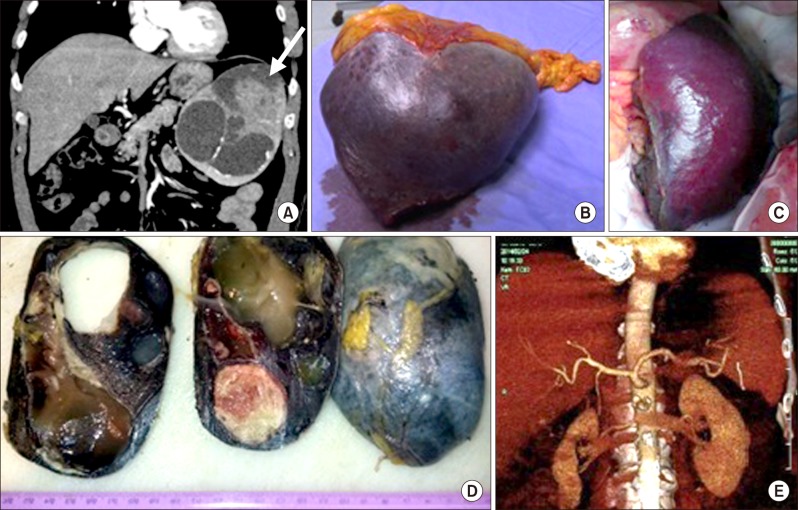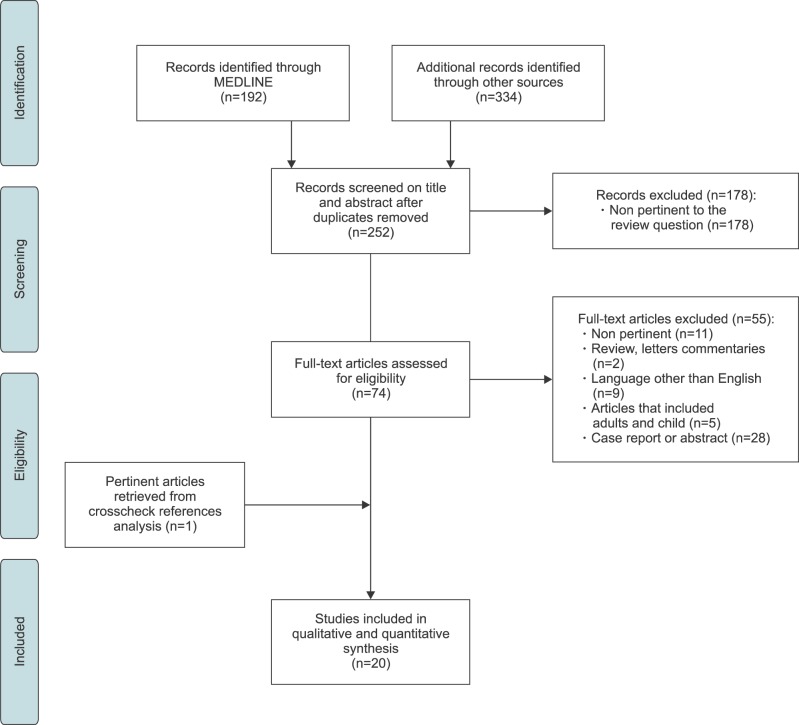Ann Hepatobiliary Pancreat Surg.
2018 May;22(2):116-127. 10.14701/ahbps.2018.22.2.116.
Partial splenectomy: A case series and systematic review of the literature
- Affiliations
-
- 1Department of Oncological and General Surgery, S.G. Moscati Hospital, Avellino, Italy. crafa@tiscali.it
- 2Department of Hematology and Stem Cell Transplantation, S.G. Moscati Hospital, Avellino, Italy.
- 3Department of General and Emergency Surgery, Civico Hospital, Palermo, Italy.
- KMID: 2412426
- DOI: http://doi.org/10.14701/ahbps.2018.22.2.116
Abstract
- BACKGROUNDS/AIMS
Partial splenectomy (PS) is a surgical option for splenic mass, in order to reduce postoperative complications and preserve the splenic function. Despite this, data in literature is still scarce. The present study aimed to reveal our recent experience and provide a comprehensive overview of the feasibility and complications related to various surgical approaches.
METHODS
Data of patients who underwent PS, between 2014 and 2017 were retrospectively reviewed. Literature was searched for studies reporting all types of PS in adult or adolescent patients.
RESULTS
Five PS were performed in our department: two (40%) by laparoscopy and three (60%) by laparotomy. Two (40%) postoperative complications were detected, and in one of them, total splenectomy (TS) by laparotomy was finally required. There were no deaths or complications at last follow-up. Twenty studies including 213 patients were identified in the literature search. The rate of conversion from laparoscopic to open surgery was 3% (range, 5-50%) and in 3% of cases (range, 7-10%) PS was converted into total TS and the overall morbidity rate was 8% (range, 5-25%). In comparison to laparotomy, the conversion rate of laparoscopic approach to TS was 3.5% (vs. 1.4%) and a morbidity rate of 9.8% (vs. 4.3%).
CONCLUSIONS
The present review shows that PS is a viable procedure in selected cases. The mini-invasive approach seemed to be feasible despite the presence of higher rate of complications than the open technique. In future, further studies on this topic are needed by involving more patients. Furthermore, it is proposed that the development of robotic surgery could make this approach the new gold-standard technique for spleen-preserving surgery.
MeSH Terms
Figure
Reference
-
1. Rottenstreich A, Kleinstern G, Spectre G, Da'as N, Ziv E, Kalish Y. Thromboembolic events following splenectomy: risk factors, prevention, management and outcomes. World J Surg. 2018; 42:675–681. PMID: 28808782.
Article2. Ruiz-Tovar J, Priego P. Portal vein thrombosis after splenic and pancreatic surgery. Adv Exp Med Biol. 2017; 906:241–251. PMID: 27638624.
Article3. Kimmig LM, Palevsky HI. Review of the association between splenectomy and chronic thromboembolic pulmonary hypertension. Ann Am Thorac Soc. 2016; 13:945–954. PMID: 27058013.
Article4. Holdsworth RJ, Irving AD, Cuschieri A. Postsplenectomy sepsis and its mortality rate: actual versus perceived risks. Br J Surg. 1991; 78:1031–1038. PMID: 1933181.
Article5. Bisharat N, Omari H, Lavi I, Raz R. Risk of infection and death among post-splenectomy patients. J Infect. 2001; 43:182–186. PMID: 11798256.
Article6. de'Angelis N, Abdalla S, Lizzi V, Esposito F, Genova P, Roy L, et al. Incidence and predictors of portal and splenic vein thrombosis after pure laparoscopic splenectomy. Surgery. 2017; 162:1219–1230. PMID: 28919051.7. Di Sabatino A, Carsetti R, Corazza GR. Post-splenectomy and hyposplenic states. Lancet. 2011; 378:86–97. PMID: 21474172.
Article8. Uranues S, Grossman D, Ludwig L, Bergamaschi R. Laparoscopic partial splenectomy. Surg Endosc. 2007; 21:57–60. PMID: 17031738.
Article9. Van Wyck DB, Witte MH, Witte CL, Thies AC Jr. Critical splenic mass for survival from experimental pneumococcemia. J Surg Res. 1980; 28:14–17. PMID: 7359904.
Article10. Liu DL, Xia S, Xu W, Ye Q, Gao Y, Qian J. Anatomy of vasculature of 850 spleen specimens and its application in partial splenectomy. Surgery. 1996; 119:27–33. PMID: 8560382.
Article11. Christo MC. Partial regulated splenectomies. Preliminary note on the first 3 cases operated on. Hospital (Rio J). 1959; 56:645–650. PMID: 13810141.12. Morgenstern L, Shapiro SJ. Partial splenectomy for nonparasitic splenic cysts. Am J Surg. 1980; 139:278–281. PMID: 7356115.
Article13. Poulin EC, Thibault C, DesCôteaux JG, Côté G. Partial laparoscopic splenectomy for trauma: technique and case report. Surg Laparosc Endosc. 1995; 5:306–310. PMID: 7551284.14. Resende V, Petroianu A. Functions of the splenic remnant after subtotal splenectomy for treatment of severe splenic injuries. Am J Surg. 2003; 185:311–315. PMID: 12657380.
Article15. Wang L, Xu J, Li F, Zhan H, Liu H, Chen W, et al. Partial splenectomy is superior to total splenectomy for selected patients with hemangiomas or cysts. World J Surg. 2017; 41:1281–1286. PMID: 28058472.
Article16. Petroianu A. Subtotal splenectomy for the treatment of chronic lymphocytic leukemia. Ann Hematol. 2003; 82:708–709. PMID: 12904901.
Article17. Vasilescu C, Stanciulea O, Tudor S, Stanescu D, Colita A, Stoia R, et al. Laparoscopic subtotal splenectomy in hereditary spherocytosis: to preserve the upper or the lower pole of the spleen? Surg Endosc. 2006; 20:748–752. PMID: 16544076.18. Vasilescu C, Tudor S, Popa M, Tiron A, Lupescu I. Robotic partial splenectomy for hydatid cyst of the spleen. Langenbecks Arch Surg. 2010; 395:1169–1174. PMID: 20393743.
Article19. Palmieri I, Natale E, Crafa F, Cavallaro A, Mingazzini PL. Epithelial splenic cysts. Anticancer Res. 2005; 25:515–521. PMID: 15816621.20. Uranues S, Alimoglu O. Laparoscopic surgery of the spleen. Surg Clin North Am. 2005; 85:75–90. PMID: 15619530.
Article21. Hong TH, Lee SK, You YK, Kim JG. Single-port laparoscopic partial splenectomy: a case report. Surg Laparosc Endosc Percutan Tech. 2010; 20:e164–e166. PMID: 20975492.22. Giulianotti PC, Buchs NC, Addeo P, Ayloo S, Bianco FM. Robot-assisted partial and total splenectomy. Int J Med Robot. 2011; 7:482–488. PMID: 21954176.
Article23. Balaphas A, Buchs NC, Meyer J, Hagen ME, Morel P. Partial splenectomy in the era of minimally invasive surgery: the current laparoscopic and robotic experiences. Surg Endosc. 2015; 29:3618–3627. PMID: 25740639.
Article24. Bouchet A. New glimpses on the structure and vascularization of the greater omentum. Arch Anat Histol Embryol. 1962; 45:1–31. PMID: 14014337.25. Liberati A, Altman DG, Tetzlaff J, Mulrow C, Gøtzsche PC, Ioannidis JP, et al. The PRISMA statement for reporting systematic reviews and meta-analyses of studies that evaluate health care interventions: explanation and elaboration. Ann Intern Med. 2009; 151:W65–W94. PMID: 19622512.
Article26. Guyatt GH, Oxman AD, Vist GE, Kunz R, Falck-Ytter Y, Alonso-Coello P, et al. GRADE: an emerging consensus on rating quality of evidence and strength of recommendations. BMJ. 2008; 336:924–926. PMID: 18436948.
Article27. Li H, Wei Y, Peng B, Li B, Liu F. Feasibility and safety of emergency laparoscopic partial splenectomy: a retrospective analysis. Medicine (Baltimore). 2017; 96:e6450. PMID: 28422834.28. Cai H, An Y, Wu D, Chen X, Zhang Y, Zhu F, et al. Laparoscopic partial splenectomy: a preferred method for select patients. J Laparoendosc Adv Surg Tech A. 2016; 26:1010–1014. PMID: 27467747.
Article29. Lee SH, Lee JS, Yoon YC, Hong TH. Role of laparoscopic partial splenectomy for tumorous lesions of the spleen. J Gastrointest Surg. 2015; 19:1052–1058. PMID: 25835566.
Article30. Costi R, Castro Ruiz C, Zarzavadjian le, Scerrati D, Santi C, Violi V. Spleen hydatidosis treated by hemi-splenectomy: a low-morbidity, cost-effective management by a recently improved surgical technique. Int J Surg. 2015; 20:41–45. PMID: 26074292.
Article31. Han XL, Zhao YP, Chen G, Wu WM, Dai MH. Laparoscopic partial splenectomy for splenic hemangioma: experience of a single center in six cases. Chin Med J (Engl). 2015; 128:694–697. PMID: 25698206.32. de la Villeon B, Zarzavadjian Le, Vuarnesson H, Munoz Bongrand N, Halimi B, Sarfati E, et al. Laparoscopic partial splenectomy: a technical tip. Surg Endosc. 2015; 29:94–99. PMID: 24962862.
Article33. Wang X, Wang M, Zhang H, Peng B. Laparoscopic partial splenectomy is safe and effective in patients with focal benign splenic lesion. Surg Endosc. 2014; 28:3273–3278. PMID: 24939157.
Article34. Dudi-Venkata NN, Houli N, Weinberg L, Nikfarjam M. Laparoscopic partial splenectomy performed by monopolar saline-cooled radiofrequency coagulation. J Laparoendosc Adv Surg Tech A. 2014; 24:502–505. PMID: 24919036.
Article35. Paudel GR, Agarwal R, Pathania OP, Agrawal CS. Partial splenectomy for epithelial (epidermoid) splenic cysts: report of two case. JNMA J Nepal Med Assoc. 2013; 52:391–394. PMID: 24362667.
Article36. Liese J, Kohler S, Moench C, Bechstein WO, Ulrich F. Partial spleen resection with a radiofrequency needle device--a pilot study. Langenbecks Arch Surg. 2013; 398:449–454. PMID: 23385735.
Article37. Karadayi K, Turan M, Sen M. A new technique for partial splenectomy with radiofrequency technology. Surg Laparosc Endosc Percutan Tech. 2011; 21:358–361. PMID: 22002274.38. Patrzyk M, Glitsch A, Hoene A, von Bernstorff W, Heidecke CD. Laparoscopic partial splenectomy using a detachable clamp with and without partial splenic embolisation. Langenbecks Arch Surg. 2011; 396:397–402. PMID: 20683622.
Article39. Szczepanik AB, Meissner AJ. Partial splenectomy in the management of nonparasitic splenic cysts. World J Surg. 2009; 33:852–856. PMID: 19172349.
Article40. Petroianu A, Cabezas-Andrade MA, Berindoague Neto R. Laparoscopic subtotal splenectomy. Surg Laparosc Endosc Percutan Tech. 2008; 18:94–97. PMID: 18287996.
Article41. Wu SC, Wang CC, Yong CC. Partial splenectomy for benign splenic cysts with the aid of a Lin clamp: technical note. World J Surg. 2007; 31:2144–2147. PMID: 17896130.
Article42. Jiao LR, Tierris I, Ayav A, Milicevic M, Pellicci R, Navarra G, et al. A new technique for spleen preservation with radiofrequency. Surgery. 2006; 140:464–466. PMID: 16934610.
Article43. Balshem H, Helfand M, Schünemann HJ, Oxman AD, Kunz R, Brozek J, et al. GRADE guidelines: 3. Rating the quality of evidence. J Clin Epidemiol. 2011; 64:401–406. PMID: 21208779.
Article44. Hong TH, You YK, Lee KH. Transumbilical single-port laparoscopic cholecystectomy: scarless cholecystectomy. Surg Endosc. 2009; 23:1393–1397. PMID: 19118436.45. Lee YS, Kim JH, Moon EJ, Kim JJ, Lee KH, Oh SJ, et al. Comparative study on surgical outcomes and operative costs of transumbilical single-port laparoscopic appendectomy versus conventional laparoscopic appendectomy in adult patients. Surg Laparosc Endosc Percutan Tech. 2009; 19:493–496. PMID: 20027094.
Article46. Vasilescu C, Stanciulea O, Tudor S. Laparoscopic versus robotic subtotal splenectomy in hereditary spherocytosis. Potential advantages and limits of an expensive approach. Surg Endosc. 2012; 26:2802–2809. PMID: 22476842.
Article47. Berelavichus SV, Smirnov AV, Ionkin DA, Kriger AG, Dugarova RS. Robot-assisted and laparoscopic partial splenectomy for nonparasitic cysts. Khirurgiia (Mosk). 2015; (7):41–48.
Article48. Habib NA, Spalding D, Navarra G, Nicholls J. How we do a bloodless partial splenectomy. Am J Surg. 2003; 186:164–166. PMID: 12885611.
Article49. Itamoto T, Fukuda S, Tashiro H, Ohdan H, Asahara T. Radiofrequency-assisted partial splenectomy with a new and simple device. Am J Surg. 2006; 192:252–254. PMID: 16860640.
Article50. Gumbs AA, Bouhanna P, Bar-Zakai B, Briennon X, Gayet B. Laparoscopic partial splenectomy using radiofrequency ablation. J Laparoendosc Adv Surg Tech A. 2008; 18:611–613. PMID: 18721016.
Article51. Stacey MJ, Rampaul RS, Rengaragan A, Duffy JP, Macmillan RD. Use of FloSeal matrix hemostatic agent in partial splenectomy after penetrating trauma. J Trauma. 2008; 64:507–508. PMID: 17413522.
Article52. Mignon F, Brouzes S, Breitel DL, Bastie JN, Poirier H, Legendre C, et al. Preoperative selective embolization allowing a partial splenectomy for splenic hamartoma. Ann Chir. 2003; 128:112–116. PMID: 12657551.53. Guan YS, Hu Y. Clinical application of partial splenic embolization. ScientificWorldJournal. 2014; 2014:961345. PMID: 25538966.
Article54. Kimura F, Ito H, Shimizu H, Togawa A, Otsuka M, Yoshidome H, et al. Partial splenic embolization for the treatment of hereditary spherocytosis. AJR Am J Roentgenol. 2003; 181:1021–1024. PMID: 14500222.
Article55. Coccolini F, Montori G, Catena F, Kluger Y, Biffl W, Moore EE, et al. Splenic trauma: WSES classification and guidelines for adult and pediatric patients. World J Emerg Surg. 2017; 12:40. PMID: 28828034.56. Liu S, Lei J, Zeng Z, Zhang Y. Management of traumatic splenic rupture in adults: a single center's experience in mainland China. Hepatogastroenterology. 2014; 61:966–971. PMID: 26158150.
- Full Text Links
- Actions
-
Cited
- CITED
-
- Close
- Share
- Similar articles
-
- Laparoscopic Splenectomy in a Case of Stable Blunt Abdominal Trauma
- Laparoscopic Partial Splenectomy for Splenic Pseudocyst
- Efficacy and Safety of Gabapentin in the Treatment of Chronic Cough: A Systematic Review
- Disadvantages of Complete No. 10 Lymph Node Dissection in Gastric Cancer and the Possibility of Spleen-Preserving Dissection: Review
- Laparoscopic Splenectomy for Patients with Idiopathic Thrombocytopenic Purpura



